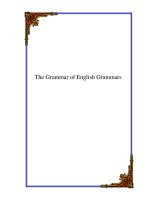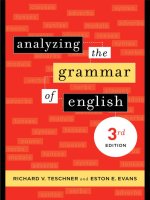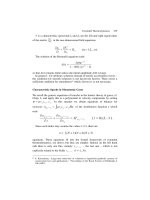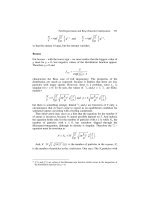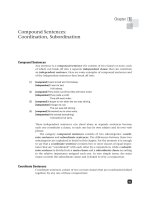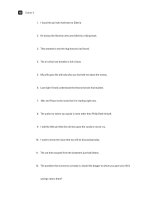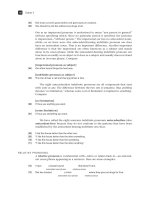Analyzing the Grammar of English Third Edition phần 7 pdf
Bạn đang xem bản rút gọn của tài liệu. Xem và tải ngay bản đầy đủ của tài liệu tại đây (260.19 KB, 25 trang )
Chapter 5
138
[62] One must cut one’s grass before one goes away on vacation.
[63] One should try and live without any drugs at all.
One as an impersonal pronoun is understood to mean “any person in general”
without specifying which. Since no particular person is specified, the pronoun
is impersonal—“without person.” The impersonal one has no antecedent noun,
while—as we have seen—the antecedent-bearing indefinite pronoun one does
have an antecedent noun. That is an important difference. Another important
difference is that the impersonal one often functions as a subject and stands
alone in its noun phrase, while the antecedent-bearing indefinite pronoun one
functions as readily as an object as it does as a subject and usually does not stand
alone in its noun phrase. Compare:
[impersonal pronoun as subject]
[64] One often learns things the hard way.
[indefinite pronoun as subject]
[65] This man drives a cab and that one drives a limo.
The eight antecedentless indefinite pronouns are all compounds that start
with some or any. The difference between the two sets is semantic; thus anything
denotes ‘no limitation,’ whereas some sort of limitation is implied in something.
Compare:
[no limitation]
[66] I’ll buy you anything you want.
[some limitation]
[67] I’ll buy you something you want.
We have called the eight some/any indefinite pronouns antecedentless (also
antecedent-free) because they do not conform to the patterns that have been
established by the antecedent-bearing indefinite one; thus:
[68] I like this house better than the other one.
[69] *I like this house better than the other something.
[70] *I like this house better than the something.
[71] *I like this house better than the other anything.
1
RELATIVE PRONOUNS
A relative pronoun is coreferential with—refers or relates back to—an anteced-
ent noun phrase appearing in a sentence. Here are some examples:
[72] I have a basset hound that doesn’t bark.
antecedent noun phrase relative pronoun
[73] She has located a clinic where they give out drugs for free.
antecedent noun phrase relative pronoun
113-142.Teschner.05.indd 138113-142.Teschner.05.indd 138 4/2/07 6:12:49 PM4/2/07 6:12:49 PM
139
Relative pronouns typically initiate relative clauses, which as such would have
their own subject and verb if they were separate sentences. To generate a relative
pronoun we take a sentence such as (74) that contains a repeated noun phrase.
We then replace it with a relative pronoun, thus:
[74] I have a basset hound. The basset hound doesn’t bark.
repeated noun phrase
[75] I have a basset hound that doesn’t bark.
relative pronoun
replacing the repeated
noun phrase
Relative clauses are discussed in full in chapter 6. For the moment it is enough to
know which eight pronouns can function as relatives. They are:
that: I know a man that poisoned his neighbor’s dog.
when: There will come a time when such crimes are punished.
where: She knows a place where we can be alone.
which: The car, which gets eighty miles to the gallon, is not yet on the market.
who: We need a principal who can stand up to the gangs.
whom: I once knew a man whom I admired greatly.
whose: I knew a bartender whose wife was a famous chemist.
why: I know the reason why you said that.
In highly stigmatized usage, what also functions as a relative pronoun, for exam-
ple, Him ‘n’ me knows this guy what bumped off his wife. Prescriptive English utterly
rejects what as a relative pronoun.
The word that needs a bit more discussion here. We have already seen that
that can readily function as a demonstrative, and we have just examined the that
that is used as a relative pronoun. However there is a third high frequency usage
of that—as something called a complementizing conjunction (comp-con)—that
we will not go into in any depth until chapter 8; for the moment it will suffice to
know this: Any that that is neither a demonstrative determiner, a demonstrative
pronoun, or a relative pronoun is a comp-con, which basically serves to join
one detachable clause to another in a sentence containing a subordinate clause
such as:
[76] I know that he is rich.
[Detachable main clause: I know [something].]
S V DO
[Detachable subordinate clause: He is rich.]
S V adjective complement
INTERROGATIVE PRONOUNS
Usable as question words at the beginning of wh/co-questions are all the relative
pronouns that begin with wh- plus how and what. These are the wh-words, which
we illustrate below:
Pronouns
113-142.Teschner.05.indd 139113-142.Teschner.05.indd 139 4/2/07 6:12:50 PM4/2/07 6:12:50 PM
Chapter 5
140
what: What do you do for a living?
when: When does the next flight depart?
where: Where oh where did my little dog go?
which: Which witch traded in her broomstick for a Lear jet?
who: Who knows what The Shadow knows?
whom: To whom am I speaking?
why: Why do you do the things you do?
how: How many times must I tell you that?
In chapter 3 we analyzed the syntax of the question types involving interrogative
pronouns.
Pro-Words: Pronoun-Like Words for Clauses, Phrases, Adjectives, and Adverbs
These forms refer back to antecedent entities that are not nouns or noun phrases;
that is why these forms are called pro-words and not pro-“nouns.” The entity
referred back to can be a complete clause:
[77] Lulu said she was going to die. I told her I really didn’t think so.
complete clause pro-word
[78] Miguel insisted he would never fall in love again, to which I answered that I flat out
complete clause
refused to believe it.
pro-word
Or it can be an entire verb phrase:
[79] Kowalczyk climbed the Sears Tower before Rydz did so.
verb phrase pro-words
It can be an adjective:
[80] Wile E. Coyote isn’t really despicable; he just seems so.
adjective pro-word
Or an adverb:
[81] Di always does her work carefully; by working thus, she manages to achieve perfection.
adverb pro-word
The word there can function as a prepositional phrase pro-word (in which the
prepositional phrase forms perform an adverbial function):
[82] Sally was playing in the attic and left all her toys there.
The following items, then, can function as pro-words: it, so, there, thus.
113-142.Teschner.05.indd 140113-142.Teschner.05.indd 140 4/2/07 6:12:51 PM4/2/07 6:12:51 PM
141
Activity 5.5
THINKING IT THROUGH
A. Identify and label all demonstratives (whether determiners or pronouns), all indefinite pro-
nouns (whether antecedent-bearing or antecedent-free), all impersonal pronouns, all relative
pronouns, all interrogative pronouns, and all pro-words in the following sentences.
1. That car that you had last year was a lot more economical than this one.
2. I know a woman who takes in boarders that cannot pay.
3. How good are these?
4. Someone once asked me where I was from.
5. One often gets into trouble, so it’s obvious that one can never be too careful.
6. Be careful with that one. It breaks easily.
7. Won’t anybody out there do something to mend a broken heart?
8. I bought this bracelet at Tiffany’s and then I left it there.
9. These new cars look shiny and those old ones look weather beaten.
10. That man arrived long after the hour when the trains stop.
11. I knew that I was going to rob him, and I told him so.
12. Which witch bewitched this one? She looks terrible!
13. Who knows what will happen next?
14. Does anyone know what time it is?
Pro-Words: Pronoun-Like Words for Clauses, Phrases, Adjectives, and Adverbs
113-142.Teschner.05.indd 141113-142.Teschner.05.indd 141 4/2/07 6:12:52 PM4/2/07 6:12:52 PM
Chapter 5
142
15. Alice is a superb violinist and she has been one since age twelve.
16. She sold me these, not those; I want a refund and I already told her so.
B. Write original sentences that use the following words as the parts of speech indicated.
1. anyone as an antecedent-free indefinite pronoun
2. what as an interrogative pronoun
3. that as a relative pronoun
4. so as a pro-word
5. those as a demonstrative pronoun
6. one as an antecedent-bearing indefinite pronoun
7. this as a demonstrative pronoun
8. there as a pro-word
9. when as a relative pronoun
10. something as an antecedent-free indefinite pronoun
11. which as an interrogative pronoun
12. which as a relative pronoun
13. that as a demonstrative determiner
14. that as a demonstrative pronoun
Note
1. The somebody/someone/something/somewhere series can take an antecedent when
appearing as predicate pronominatives, thus: Barry is somebody/someone I really
enjoy; Kim Chee is something we just cannot live without; San Francisco is somewhere
that tourists really like to visit. In that sense, then, the some series is not consistently
antecedentless, yet the fact that these four words typically appear without an ante-
cedent—Somebody/Someone needs to phone 911; Something is bothering me; Somewhere
somebody has got to know something—has prompted us to continue classifying them as
antecedentless.
113-142.Teschner.05.indd 142113-142.Teschner.05.indd 142 4/2/07 6:12:53 PM4/2/07 6:12:53 PM
143
Chapter
6
Adjectives and Relative Clauses
Attributive and Predicate Adjectives: Identification and Syntax
There are two positions where an English adjective may appear: (1) within the
same noun phrase as the noun it modifies whether coming before or after it (the
attributive position), or (2) not within the noun phrase whose noun it modifies
but, instead, right after the clause’s verb (the predicate position). Here are some
examples:
Attributive
1.1 —before the modified noun (the prenominal attributive position)
a. a big poodle
b. the old computer
c. some pretty flowers
d. a poor bedraggled sweet little old Polish lady
1.2 —after the modified noun (the postnominal attributive position)
a. a poodle big with a not-yet-born litter
b. a course open to all students
c. a driver asleep at the wheel
Predicate
2. a. the poodle is big
b. some men were sick
c. the flowers look pretty
d. the feather appears ruffled
e. the computer only seems old
While one of the most typical characteristics of English attributive adjec-
tives is that they appear in the prenominal position, many attributive adjectives
can also appear postnominally (thus big in nos. 1.1.a and 1.2.a above), and a
few can appear only postnominally (thus asleep in 1.2.c; cf. the ungrammati-
cal *an asleep driver). However, the expected or unmarked position for English
adjectives is the prenominal attributive position. If an adjective appears in the
postnominal attributive position, then that adjective will originally have formed
part (or is assumed to be able to form part) of a restrictive relative clause that
has undergone a transformation deleting the relative pronoun and the verb. The
deleted verb will be a copula (be) or a copula-like verb (seem, appear, look). By
deleting the pronoun and the verb we produce a gap, in the process first referred
143-170.Teschner.06.indd 143143-170.Teschner.06.indd 143 4/2/07 6:14:33 PM4/2/07 6:14:33 PM
Chapter 6
144
to in chapter 5 as gapping. (Not all languages do gapping. Speakers of gapless
languages often find gapping especially tough to comprehend.) In the following
examples, gapping produces the gaps that appear between brackets:
[1] a course [that is] open to all students
deletable
[2] a driver [who was] asleep at the wheel
deletable
[3] a feather [which appears] ruffled beyond belief
deletable
[4] a decade [that seemed] lovely to remember
deletable
See this chapter’s section on relative clauses for more information about relative
clauses in general and the gapping of the relative pronouns that initiate them.
In the main, any attributive adjective whether pre- or postnominal can be
viewed as derived ultimately from a relative clause containing be plus the adjec-
tive itself. Thus note the following sentences:
[5] The old man [= the man {who is} old] lived to be 99.
[6] Give me two and a half pieces of used bubble gum [= gum {that has been} used].
Activity 6.1
THINKING IT THROUGH
A. Each of the following words is normally an adjective or can be used as one. Tell whether
the word can appear as a prenominal attributive only, as a postnominal attributive only, as
a predicate only, as all three, or as any two of them. Then use each adjective in one original
sentence for each of the possibilities allowed.
Example of how to proceed:
X. nice: “This adjective can appear as either a prenominal attributive or as a predicate (but
not as a postnominal attributive). Here is one example of each possibility: [prenominal
attributive] We had a nice time; [predicate] The weather was nice.”
1. gray
2. awake
3. main
4. medical
5. former
143-170.Teschner.06.indd 144143-170.Teschner.06.indd 144 4/2/07 6:14:34 PM4/2/07 6:14:34 PM
145
6. only
7. extravagant
8. galore
9. daily
10. sleepy
11. responsible
12. stupid
13. innocent
14. total
15. Irish
B. Locate the adjectives and then describe each one as prenominal attributive, postnominal
attributive, or predicate.
Example of how to proceed:
X. The little old poodle filthy with mud is sad. “The adjectives are little, old, filthy, and sad.
Little and old are prenominal attributives, filthy is a postnominal attributive, and sad is a
predicate adjective.”
1. Jennifer bought a dripping taco at Taco Town.
2. Send me the severed head of that brash young idealistic prophet.
3. Sam only appears exhausted after playing a full round of golf.
4. Julie rubbed expensive French ointment on tired fingers aching to the bone.
Attributive and Predicate Adjectives: Identification and Syntax
143-170.Teschner.06.indd 145143-170.Teschner.06.indd 145 4/2/07 6:14:35 PM4/2/07 6:14:35 PM
Chapter 6
146
5. Sally is the recently appointed editor of a prestigious journal.
6. A sizzling roast dripping with fat landed on the back seat of my father’s ancient Hupmobile.
7. Any face covered with acne is ugly in the eyes of prejudiced beholders.
8. Richard and Steve invested heavily in purebred collies.
9. The landed immigrant breathed a sigh pregnant with meaning.
10. Grant was awarded a fellowship whose terms were generous to a fault.
11. My sweet little old slivovitz-drinking Slovenian grandmother arrived in Chicago in 1923.
12. The handsome twins seemed inseparable until one of them had a terrible accident.
WRITING IT OUT
C. Write three sentences imitating each of the following patterns. (Be sure you concentrate
on getting the adjectives right.)
Example of how to proceed:
X. I want to take a good look at the correct answers. [You imitate by writing:] “She insists
on having a wonderful time at the jolly retirement party.”
1. Mary had a little lamb whose fleece was very white.
2. Nimble Jack jumped over the tall thick candlestick.
3. Carrie is merry while Sarie is contrary.
4. The powerful warlord shouted out a rapid command frightening to hear.
143-170.Teschner.06.indd 146143-170.Teschner.06.indd 146 4/2/07 6:14:35 PM4/2/07 6:14:35 PM
147
The Syntax of Prenominal Attributive Adjectives
The following ungrammatical phrases tell us why it is so important to establish
rules describing the syntax of different types of attributive adjectives:
[7] *a hot nice bath
[8] *a winter cold day
[9] *the fat big man
[10] *several red little schoolhouses
[11] *an Italian blue small automobile
Over the years, linguists have come up with increasingly fine-tuned rules for
ordering strings of prenominal attributive adjectives. What we present here is a
simplification of those rules, one that recognizes the fact that you seldom find
more than four adjectives in the same phrase. (Thus something like a beautiful
little dented old white Dutch metal teapot would be roundly criticized on stylistic
grounds and would require a major feat of memory to recall.) Figure 6a presents
the simplified rules for ordering prenominal attributive adjectives. (Nonadjective
noun phrase components such as determiners and the noun itself are enclosed
in brackets.) While even figure 6a’s simplified ordering is complex and does not
lend itself to an accurate generalization, the following rule of thumb does a fairly
good job of getting at the heart of prenominal attributive adjective syntax: The
more intrinsic the adjective is to the nature of the noun, the closer it will be to
the noun.
The Syntax of Prenominal Attributive Adjectives
Activity 6.2
THINKING IT THROUGH
A. Correct the following sentences if they need correcting, and explain your correction by
citing the rules for prenominal attributive adjective ordering.
1. She’s a Japanese small beautiful woman.
2. I want a big fat Slobovian pig to take to market.
3. They got a long lovely short-haired dachshund as a present.
[1 {i.e., the first word in the noun phrase}: the determiner]
2: the opinion-expresser, e.g., good, bad, wonderful, nice
3: the measurer, with size first, then shape, e.g., big, little, round, square
4: the condition- or age-expresser, e.g., sick, young
5: the color
6: the origin or material
[7 {i.e., the last word in the noun phrase}: the noun]
Figure 6a The Ordering of Prenominal Attributive Adjectives
143-170.Teschner.06.indd 147143-170.Teschner.06.indd 147 4/2/07 6:14:36 PM4/2/07 6:14:36 PM
Chapter 6
148
4. He sold me a green medium-sized sweater.
5. Many fine upstanding young boys were led to slaughter.
6. That was a French little nice restaurant you took me to.
7. She said she would give me a new big brand-spanking great Cadillac for my birthday.
8. I understand that the Angolan bronze ancient marvelous statue they brought back was
stolen.
Adjectives and Adverbs: Comparative and Superlative Forms
As we recall from chapter 1, a useful way to tell if a word can function as an adjec-
tive is to run it through the equative-/comparative-/superlative-form test, thus:
Equative Comparative Superlative
old older oldest
as *aser *assest
Old, then, is unquestionably an adjective whereas as is not.
Not all functioning adjectives will pass this simple morphological test, since
a general rule of English morphology is that all adjectives of three syllables or
more—and some adjectives of two syllables—will create their comparative by
putting more just before the equative form (more interesting) and will create their
superlative by putting most before the equative form (most interesting). The bound
morphemes -er and -est are attached as suffixes to all adjectives of one syllable
and to certain types of bisyllabic adjectives. (See the next paragraph for more
information on this.)
CHANGING EQUATIVES TO COMPARATIVES: WHEN
TO USE MORE AND WHEN TO USE -ER
One-syllable equatives: When changing one-syllable equatives into compar-
atives, use only the bound morpheme -er; for example, nice → nicer, sweet →
sweeter, sick → sicker, tall → taller, grim → grimmer.
Two-syllable equatives: All languages change, even in times of almost uni-
versal literacy (and—as a putative consequence—almost universal exposure to
large amounts of written text, which presumably retards changes in the spo-
ken language itself). In times gone by, the rules we give below reflected general
usage. Recently, however, growing numbers of English speakers have come to
prefer more instead of -er to form all two-syllable equatives’ comparatives and
not just the ones that we draw attention to below. So the simplest possible rule
for English learners to employ is this: when you are not sure, just use more to
comparativize any two-syllable equative. Yet using more to express one-syllable
143-170.Teschner.06.indd 148143-170.Teschner.06.indd 148 4/2/07 6:14:36 PM4/2/07 6:14:36 PM
149
equatives’ comparativity remains somewhat stigmatized—thus: He was more tall
than me, but she was more short → He was taller than I, but she was shorter—and the
double comparative marking of He was more taller than me, but she was more shorter
remains highly stigmatized. What follows is a bipartite and therefore somewhat
more complicated rule that increasingly reflects an older, more conservative (yea
prescriptive) way of using more and -er:
1. When making comparatives out of the following two-syllable equatives,
use only the bound morpheme -er:
-y (happy → happier, lucky → luckier, lazy → lazier, crazy → crazier, etc.)
-ple (simple → simpler, etc.)
-ble (humble → humbler, etc.)
-tle (little → littler, etc.)
-dle (idle → idler, etc.)
2. Use either -er or more with all other two-syllable bases, for example:
-ly: friendly—either friendlier or more friendly
-ow: shallow—shallower/more shallow
-er: eager—eagerer/more eager
-some: handsome—handsomer/more handsome
three-syllable equatives: When making comparatives out of any equatives that
have three or more syllables, use only more:
discriminatory →
more discriminatory
abominable → more abominable
conspicuous → more conspicuous
respectful → more respectful
insolent → more insolent
Note that if a two-syllabled equative takes -er alone, any derivation conver ting
the two syllables to three does not delete the -er; thus happy → happier, unhappy →
unhappier.
Seven equatives take irregular comparative forms, that is, forms whose com-
paratives use neither -er nor more. The seven are:
Equative Comparative
much more (Sam has much money but I have more money)
many more (Liz has many problems but I have more problems)
good better (Garlic capsules are good but real garlic is better)
bad worse (The sausage was bad and the wurst was worse)
far farther (measurable linear distance)
further (nonlinear distance)
(Increasingly, the difficult-to-remember farther/further distinc-
tion is resolved in favor of further, even in totally nonstigmatized
usage, thus: Stephen lives far from me but Geri lives even further.
[Cf. the highly prescriptive . . . but Geri lives even farther.])
few fewer (I have few students but you have even fewer students than I do)
little less (You have very little time but I have even less time)
Adjectives and Adverbs: Comparative and Superlative Forms
143-170.Teschner.06.indd 149143-170.Teschner.06.indd 149 4/2/07 6:14:37 PM4/2/07 6:14:37 PM
Chapter 6
150
Comments on fewer and less: In recent years the irregular comparative less has
been slowly replacing the regular comparative fewer. So instead of the prescrip-
tive You have few cows and even fewer pigs, more people (including the media) now
say You have few cows and even less pigs. Prescriptive grammar limits less to mass
nouns—I have less money; She uses less energy; They need less encouragement—and
fewer to count nouns: This year I have fewer kids in my class; The neighbors have
fewer birds in their backyard; We have fewer cats than we’d like.
THE MORPHOLOGY OF SUPERLATIVES: WHEN TO USE -EST AND WHEN TO USE MOST
Morphological classifications and processes applying to comparatives apply to
superlatives too:
Equative Comparative Superlative
tall taller tallest
happy happier happiest
simple simpler simplest
friendly friendlier/more friendly friendliest/most friendly
quiet quieter/more quiet quietest/most quiet
conspicuous more conspicuous most conspicuous
respectful more respectful most respectful
Irregular comparatives and superlatives
much more most
many more most
little less least
good better best
bad worse worst
far farther/further farthest/furthest
EQUATIVES, COMPARATIVES, AND SUPERLATIVES:
THEIR STRUCTURES AND MEANINGS
First we must define some terms:
An equative structure typically states that A and B are equal when it comes
to being, doing, or having X:
[12] I have as much money as you do.
[13] There are as many people in Albuquerque as there are in Tucson.
[14] I work as hard as he does.
[15] They are as tough as we are.
A comparative structure typically indicates that A has, is, or does more than B:
[16] I have more money than you do.
[17] There are more people in Fort Dodge than there are in Grundy Center.
[18] I work harder than he does.
[19] They are tougher than we are.
A superlative structure attributes to A the highest or the lowest quality on a
scale:
143-170.Teschner.06.indd 150143-170.Teschner.06.indd 150 4/2/07 6:14:38 PM4/2/07 6:14:38 PM
151
[20] I have the most money in town.
[21] Mexico D.F. is the largest city in the world.
[22] I work hardest of all.
[23] Tubby is the smartest kid in the whole third grade.
[24] Professor Fidgit owns the most books on Ancient Aramaic of anyone in his profession.
The superlative deals in absolutes. While it is often used to compare one
entity to more than two (That cow is the most bovine animal in the whole herd!), a
superlative structure can also be used to compare just two entities for X, provided
that the X-ness is being viewed as measurable by some sort of absolute standard;
thus Rockefeller or Onassis—which one of them was the richest millionaire? Using the
superlative to compare just two entities is especially typical of colloquial language
and is still condemned by some prescriptivists, who insist that only the compara-
tive can be used for that purpose: Which one of them was the richer millionaire?
Adjectives and adverbs directly enter into equative, comparative, and super-
lative structures; nouns (and verbs) enter into them in a more peripheral way.
Nouns can be modified by quantifiers such as many, much, few, little, several, a
lot of, etc., thereby enabling them to participate in comparative and superlative
structures. Verbs in verb phrases can be followed by an expression of quantity,
traditionally called an adverbial of extent or degree, for example, Sam jogs a little
every morning; Samantha used to bake cookies a lot; SueAnn bakes more than she does.
The following section presents a discussion of all twelve possible tokens—each
of the three structures as shown in each of the four parts of speech—adjectives,
adverbs, nouns, verbs—that equative/comparative/superlative structures are used
in. We also note the relationship between a particular structure’s form and the
special or unexpected meaning it may have.
Equative structures
. . . as as . . .
Equative meanings
adjective [25] He’s as old as you (are).
adverb [26] He eats as fast as you (do).
noun [27] He has as many books as you (do).
verb [28] He studies as much as you (do).
Elements appearing between parentheses are optional. Deleting the verb creates
an elliptical clause.
Comparative structures
er than . . .
. . . more than . . .
. . . fewer than . . .
. . . less than . . .
Comparative meanings
adjective
[29] He’s older than you (are).
[30] He’s not as young as you (are).
Adjectives and Adverbs: Comparative and Superlative Forms
143-170.Teschner.06.indd 151143-170.Teschner.06.indd 151 4/2/07 6:14:39 PM4/2/07 6:14:39 PM
Chapter 6
152
Note that while the structure of (30) is equative, its meaning is comparative.
Sentence (30) demonstrates that when equative structures are negated (not as
young as you) their meaning becomes comparative; it is as if by negating the
structure you kick the meaning one level higher, from equative (the lowest) to
comparative (the next higher up). Here are two more examples of equative struc-
tures that have comparative meanings because the structure’s verb is negated by
the addition of not:
[31] I don’t like Mozart as much as you do. [This means you like Mozart more than I do.]
[32] He didn’t have as many properties as you did. [This means you had more properties than he had.]
Adverb
[33] He eats faster than you (do).
[34] He doesn’t eat as slowly as you (do). [Sentence (34) is another example of a negated equative
construction producing a comparative meaning.]
Noun
[35] She has more money than you (do).
[36] She has fewer properties than you (do).
[37] Joan has less income than he (does).
[38] Uncle Thigbert doesn’t have as many chickens as Aunt Mamie does. [Another negated equative
structure producing a comparative meaning.]
Verb
[39] She studies more than you (do).
[40] Slobovians work harder than Cherts (do).
Superlative structures
. . . the (e)st of . . .
. . . the least/most of . . .
Superlative meanings
adjective
[41] She’s the oldest of all.
[42] She’s the most paranoid of all.
[43] No one is as paranoid as she (is). [Note that this negated equative structure produces a superla-
tive meaning, and that the following negated sentence achieves the same effect with a com-
parative structure.]
[44] No one is more paranoid than she (is).
Adverb
[45] He eats the fastest of all.
[46] He eats faster than anyone.
Note that while the structure of (46) is comparative, its meaning is superlative
because of the presence in the sentence of the indefinite pronoun anyone, which
expands the sentence’s parameters to the point of de facto universality: than
anyone taken literally could truly encompass the world entire! Sentence (46) then
is an example of a comparative structure used to superlative effect. Here are four
more examples of the same phenomenon:
143-170.Teschner.06.indd 152143-170.Teschner.06.indd 152 4/2/07 6:14:39 PM4/2/07 6:14:39 PM
153
[47] It rained harder than anything I had ever seen.
[48] Gordon is skinnier than anyone we have ever met.
[49] No one eats slower than he (does). [This comparative structure produces a superlative meaning
because of the presence of the negative indefinite pronoun no one.]
[50] No one eats as slow as he (does). [This equative structure gives a superlative meaning because of
the presence of no one.]
Noun
[51] Professor Fidgit has the most books of anyone (that I know).
[52] He has more books than anyone (that I know). [This comparative structure produces a superlative
meaning because of the presence of anyone.]
[53] No one has as many books as he (does). [Again, equative structure, superlative meaning.]
Verb
[54] He studies the most of anyone (that I know).
[55] He studies more than anyone (that I know).
EQUATIVES WITH COMPARATIVE MEANINGS AND EQUATIVES
AND COMPARATIVES WITH SUPERLATIVE MEANINGS
By now it is clear that equative structures take on comparative meanings when
the verb is negated by the addition of not:
[56] He’s not as young as you (are).
[57] He doesn’t eat as slowly as you (do).
It is also clear that both equative and comparative constructions take on superla-
tive meanings when the subject of the sentence is the negative indefinite pro-
noun no one—
[58] No one studies as much as she does.
[59] No one studies more than she does.
—and when the person that the subject is compared to is the indefinite pronoun
any one:
[60] Quincy studies more than anyone.
[61] Quincy has more money than anyone.
This shows how important it is to pay attention to meaning as well as to struc-
ture when figuring out the point of a sentence.
Activity 6.3
THINKING IT THROUGH
A. Give the comparative and the superlative forms for each of the following equatives.
1. dumb
2. ravishing
3. tricky
Adjectives and Adverbs: Comparative and Superlative Forms
143-170.Teschner.06.indd 153143-170.Teschner.06.indd 153 4/2/07 6:14:40 PM4/2/07 6:14:40 PM
Chapter 6
154
4. subtle
5. devastated
6. reptant
7. slow
8. valid
9. lovely
10. negotiable
11. urgent
12. luscious
13. sadistic
14. mobile
15. gross
16. cannibalistic
B. Describe the following sentences with regard to (1) structure and (2) equative, compara-
tive, or superlative meaning.
Example of how to proceed:
X. No one is as intelligent as Vincent. “The structure is equative (as as) but
the meaning is superlative because of the negated subject (no one).”
1. I finally have as many friends as Joe.
2. Carol is the most prolific writer of her generation.
3. She has written more successful fiction than anybody.
4. Sue is not as pretty as you are, but she certainly is bright.
5. Mirror, mirror on the wall, who’s the fairest of them all?
6. Dr. Finkel sees four fewer patients than Dr. Schlepper.
7. I never dance as slowly as you.
8. Not one single Boy Scout earned as many merit badges as Percival did.
143-170.Teschner.06.indd 154143-170.Teschner.06.indd 154 4/2/07 6:14:41 PM4/2/07 6:14:41 PM
155
9. Some people say that prostitution is the oldest profession in the world.
10. I work harder than Tom, Rick, or Harriet.
11. The anteater scarfs down ants faster than any other animal.
12. No one plays bridge as well as my Great-Aunt Agatha.
WRITING IT OUT
C. Write one original sentence corresponding to each of the following descriptions.
1. superlative construction, superlative meaning; noun
2. equative construction, superlative meaning; noun
3. comparative construction, comparative meaning; adjective
4. comparative construction, superlative meaning; verb
5. equative construction, equative meaning; adverb
6. comparative construction, comparative meaning; adverb
7. superlative construction, superlative meaning; adjective
8. equative construction, equative meaning; noun
9. comparative construction, superlative meaning; adverb
10. comparative construction, comparative meaning; noun
Relative Clauses, Relative Pronouns, and Their Antecedents
You will recall from chapter 5 that there are seven relative pronouns—that, when,
where, which, who/whom, whose, and why
1
—and that a relative pronoun refers or
“relates back” to an antecedent noun phrase appearing earlier in the sentence.
What types of antecedents can relative pronouns take? Semantic (meaning-
based) considerations play a large role in determining this. For example, when’s
antecedent must refer to something definable in terms of time (I can remember
the day when you were born), and why’s antecedent must refer to some sort of
explanation or justification (Let me tell you the reason why I’ve changed my mind).
The following give the semantic parameters of the remaining relative pronouns
in alphabetical order:
that: [+/− human] (but that can never be used as the object of a preposition):
[62] The man that I saw in the store said hello.
[63] The car that sat in the driveway was for sale.
[64] *The car on that the cat sat was old and dirty.
Relative Clauses, Relative Pronouns, and Their Antecedents
143-170.Teschner.06.indd 155143-170.Teschner.06.indd 155 4/2/07 6:14:41 PM4/2/07 6:14:41 PM
Chapter 6
156
which: typically [− human] and can be used as the object of a preposition:
[65] He said that the car which belonged to that other family was not for sale.
[66] The car on which the cat had been sitting was dirty.
[67] *The man which I saw in the store said hello.
(But note: ?The people which I wanted to see weren’t there. If the [+ human] anteced-
ent is collective, which is possibly standard when referring to it. Another which
problem involves the extent to which it is acceptable if not preceded by a comma
or a preposition. Prescriptivists insist that which can only appear as a relative
pronoun in sentences like: The stolen car, which I had almost given up on, suddenly
showed up one day. Descriptivists on the other hand report that sentences like
[65] are common coin in speech and even in writing, where which can be used to
obviate the appearance of too many thats.)
who/whom: [+ human] (i.e., can only take a human antecedent)
[68] Melanie is a woman who(m) I am very fond of.
[69] *Bourbon is a drink who(m) I am very fond of.
whose: [+/− human] (the antecedent is usually human, but it can be nonhuman
as well)
[70] Scarlett was a woman whose hoopskirt never stopped twirling.
[71] Bahrain crude is the oil whose value sets the mark for the industry.
Because who/whom, whose, and that can take human antecedents, how do we
know which one to use and when? Right away we can establish some narrow
parameters for whose, as it is used solely as a possessive with sentences containing
it viewed as combinations or mergers such as:
[72] Fido is a dog.
[73] Fido’s bone is buried.
genitive/possessive
[74] Fido is a dog/Fido’s bone is buried. →→→
whose →→→
[75] Fido is a dog whose bone is buried.
That leaves who/whom and that, neither of which can ever be used as a possessive.
Here are the differences between who/whom and that:
1. that and who never function as an object of a preposition. Only whom can
do so. Here are some examples:
[76] I would like you to meet the woman to whom I am engaged.
[77] *I would like you to meet the woman to that I am engaged.
[78] *I would like you to meet the woman to who I am engaged.
Who, whom, and that are usable in all other pronoun functions, but there is a
style or register difference between them: who/whom are perceived as being more
elegant, and that is perceived as being more colloquial. For example:
143-170.Teschner.06.indd 156143-170.Teschner.06.indd 156 4/2/07 6:14:43 PM4/2/07 6:14:43 PM
157
[79] The man who(m) I made the offer to has accepted.
[80] The man that I made the offer to has accepted.
When to Use Who and When to Use Whom
The -m form—whom—simply must be used when preceded by its governing prep-
osition. In (81) the -m is optional because the governing preposition—to—does
not precede the relative pronoun. But in (82) it does, so whom is the only option.
For the same reason, -m-less (83) is ungrammatical.
[81] Who(m) are you speaking to?
[82] To whom are you speaking?
[83] *To who are you speaking?
Deleting Relative Pronouns: Creating Gaps and the Process of Gapping
In many environments the relative pronoun can be deleted. As we first learned
in chapter 5, doing so creates a gap, or empty space, that can always be filled up
again by reinserting the deleted relative pronoun. Here are some examples; the
deletable relative pronoun appears between brackets.
[84] The man [that] I made the offer to has accepted.
[85] The elephant [which] I saw yesterday died this morning.
[86] She told the girl [who(m)] you gave the money to a secret.
[87] The manager [that] you spoke about is their friend.
Gaps in English frequently occur, but even English gaps are restricted. Relative
pronoun gaps can happen only if the relative pronoun is an object in its rela-
tive clause. Such gaps cannot happen if the relative pronoun is the subject of its
relative clause. They also will not happen if the relative pronoun is immediately
preceded by the preposition that governs it. Examples:
Relative pronoun as direct object of its relative clause
[88] The elephant [which] I saw yesterday died this morning.
When deconstructed into its two constituent clauses, compound sentence (88)
produces these two simple clause sentences:
[88a] [main clause] The elephant died this morning.
[88b] [relative clause] I saw the elephant yesterday.
Here is the process by which these two deconstructed sentences are transformed
or “merged back” into a compound sentence:
[89] The elephant/I saw the elephant yesterday/died this morning. →
direct object
[90] The elephant/I saw which yesterday/died this morning. →
noun becomes pronoun
[91] The elephant/which I saw yesterday/died this morning. →
pronoun moved to start of clause
Deleting Relative Pronouns: Creating Gaps and the Process of Gapping
143-170.Teschner.06.indd 157143-170.Teschner.06.indd 157 4/2/07 6:14:44 PM4/2/07 6:14:44 PM
Chapter 6
158
→ The elephant which I saw yesterday died this morning.
The transformational process works like this: (a) in (89) you establish the fact
that the first elephant and the second elephant are the same elephant, that is,
they are coreferential; (b) in (90) you replace the noun (elephant) of the relative
clause with its corresponding relative pronoun (which); and (c) in (91) you move
the relative pronoun which to the beginning of its clause.
Relative pronoun as the subject of its relative clause
[92] The goat that chewed the tin can is my pet.
Since the relative pronoun that is the subject of its relative clause, that can-
not be deleted, and no gap can be created. Note the following ungrammatical
sentence:
2
[93] *The goat chewed the tin can is my pet.
Let us now deconstruct sentence (92) to prove that that functions as the subject
of its relative clause:
[94] The goat/the goat chewed the tin can/is my pet.
subject verb direct object
[95] The goat/that chewed the tin can/is my pet.
→→ The goat that chewed the tin can is my pet.
The Twenty Types of Relative Clauses
Elephants (88–91) and goats (92–95) merely represent the start of our discussion.
There are a total of twenty types of relative clauses all told, and the rest of them
have got to be discussed. Figure 6b lists all the twenty types and gives examples of
each. The next section tells you how to use the example sentences in figure 6b.
HOW TO USE THE EXAMPLE SENTENCES IN FIGURE 6b
The first thing you look for in figure 6b’s sentences is the main clause and its
antecedent noun or pronoun. The next thing you look for is the relative clause’s
relativized noun; it will be the noun in the relative clause that gets replaced
by the relative pronoun. (Note that all relative pronouns that can be gapped
are written between parentheses.) Here is an example of what to look for. The
example is the first sentence appearing in figure 6b.
[96] The man/ the man sings Wagner/is their friend.
main clause relative clause
antecedent noun relativized noun
→→→ The man who sings Wagner is their friend.
In (96), the main clause is The man is their friend and the relative clause is the
man sings Wagner. By combining the main clause and the relative clause we get
the whole sentence: The man who sings Wagner is their friend. When you look at the
whole sentence, you see that the relative pronoun who has replaced the relativized
143-170.Teschner.06.indd 158143-170.Teschner.06.indd 158 4/2/07 6:14:45 PM4/2/07 6:14:45 PM
159
The Twenty Types of Relative Clauses
noun the man. Just as the man is the subject of the man sings Wagner, so is the man
the subject of the man is their friend. So the main clause’s the man and the relative
clause’s who are both subjects. Figure 6b tells you that the function of the main
clause’s antecedent noun is subject and the function of the relative clause’s rela-
tive pronoun is also subject. (All “finished product” sentences are italicized.)
THE RELATIVIZATION OF THE POSSESSIVE DETERMINER WHOSE
Any one of the twenty structures in figure 6b can substitute a relative clause
beginning with whose for the relative clause it already contains. The relative
whose always indicates possession and is [+/− human]. Here is an example:
Sentence already containing a relative clause
[97] She knows the man who you discussed.
Sentence substituting whose ؉ noun for that relative clause’s pronoun
[98] She knows the man whose father you discussed.
What follows is the process whereby we generate (99):
She knows the man. + You discussed the man’s father. →→
You discussed whose father →→
whose father you discussed →→
[99] She knows the man whose father you discussed.
Function of the main
clause’s antecedent noun:
Function of the relative
clause’s relative pronoun:
subject
Subject:
1. The man/the man sings Wagner/is
their friend
→→ The man who/that sings Wagner is their
friend.
Direct Object:
2. She knows the man/the man sings
Wagner
→→ She knows the man who/that sings Wagner.
Indirect Object:
3. We gave the singer/the singer broke
the glass/a standing ovation
→→ We gave the singer who/that broke the glass a
standing ovation.
also: We gave a standing ovation to the singer
who/that broke the glass.
Object of a Preposition:
4. I’m talking with the woman/the
woman sings Wagner
→→ I’m talking with the woman who/that sings
Wagner.
Predicate Noun:
5. Giorgio is the singer/the singer hates
Wagner
→→ Giorgio is the singer who/that hates Wagner.
Figure 6b The Twenty Types of Relative Clauses
143-170.Teschner.06.indd 159143-170.Teschner.06.indd 159 4/2/07 6:14:47 PM4/2/07 6:14:47 PM
Function of the main
clause’s antecedent noun:
Function of the relative
clause’s relative pronoun:
direct object
Subject:
1. The man/you met the man/is their
friend
→→ The man (who/that) you met is their friend.
Direct Object:
2. She knows the man/you discussed
the man
→→ She knows the man (who/that) you discussed.
Indirect Object:
3. We sent the singer/Brunhilde saw the
singer/a helmet
→→ We sent the singer (who/that) Brunhilde saw
a helmet.
also: We sent a helmet to the singer (who/
that) Brunhilde saw.
Object of a Preposition:
4. I’m talking with the woman/you met
the woman
→→ I’m talking with the woman (who/that)
you met.
Predicate Noun:
5. Wagner is the composer/Giorgio hates
the composer
→→ Wagner is the composer (who/that) Giorgio
hates.
indirect object
Subject:
1. The man/I gave the helmet to the
man/is their friend
→→ The man (who/that) I gave the helmet to is
their friend.
also: The man to whom I gave the helmet is
their friend.
Direct Object:
2. I mentioned the man/you gave the
helmet to the man
→→ I mentioned the man (who/that) you gave the
helmet to.
Indirect Object:
3. He told the singer/you gave the hel-
met to the singer/a secret
→→ He told the singer (who/that) you gave the
helmet to a secret.
also: He told the singer to whom you gave the
helmet a secret.
also: He told a secret to the singer to whom
you gave the helmet.
Object of a Preposition:
4. I’m talking with the woman/I gave
the helmet to the woman
→→ I’m talking with the woman (who/that) I gave
the helmet to.
also: I’m talking with the woman to whom I
gave the helmet.
Predicate Noun:
5. Giorgio is the singer/I gave the helmet
to the singer
→→ Giorgio is the singer (who/that) I gave the
helmet to.
also: Giorgio is the singer to whom I gave the
helmet.
Figure 6b (cont’d) The Twenty Types of Relative Clauses
143-170.Teschner.06.indd 160143-170.Teschner.06.indd 160 4/2/07 6:14:50 PM4/2/07 6:14:50 PM
161
The Twenty Types of Relative Clauses
Activity 6.4
THINKING IT THROUGH
A. Underline all relative pronouns. Name each one’s (pro)noun antecedent. Then give the
case of all antecedents and relative pronouns—subject, direct object, indirect object, object
of preposition, or predicate noun. Finally, deconstruct the relativized sentence into its two
component sentences.
Example of how to proceed:
X. She gave the dog that she found a bone. “The relative pronoun is that. Its noun anteced-
ent is the dog. In terms of case, the dog is an indirect object while that is a direct object.
The two component sentences would be: [main clause] She gave the dog a bone and
[relative clause] She found the dog.”
Function of the main
clause’s antecedent noun:
Function of the relative
clause’s relative pronoun:
object of a preposition
Subject:
1. The man/you spoke about the man/is
their friend
→→ The man about whom you spoke is their
friend.
also: The man (who/that) you spoke about is
their friend.
Direct Object:
2. I know the man/you spoke about
the man
→→ I know the man about whom you spoke.
also: I know the man (who/that) you spoke
about.
Indirect Object:
3. We gave the singer/you were talking
about the singer/the helmet
→→ We gave the singer about whom you were
talking the helmet.
also: We gave the helmet to the singer about
whom you were talking.
also: We gave the singer (who/that) you were
talking about the helmet.
also: We gave the helmet to the singer (who/
that) you were talking about.
Object of a Preposition:
4. I’m talking with the woman/you
spoke about the woman
→→ I’m talking with the woman about whom you
spoke.
also: I’m talking with the woman (who/that)
you spoke about.
Predicate Noun:
5. Giorgio is the singer/I’m talking with
the singer
→→ Giorgio is the singer with whom I’m talking.
also: Giorgio is the singer (who/that) I’m talk-
ing with.
Figure 6b (cont’d) The Twenty Types of Relative Clauses
143-170.Teschner.06.indd 161143-170.Teschner.06.indd 161 4/2/07 6:14:52 PM4/2/07 6:14:52 PM
